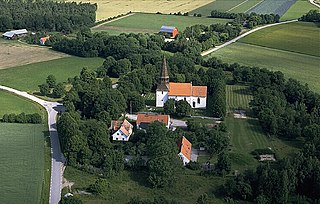
Fleringe is a populated area, a socken, on the Swedish island of Gotland. It comprises the same area as the administrative Fleringe District, established on 1 January 2016.

Lokrume is a populated area, a socken, on the Swedish island of Gotland. It comprises the same area as the administrative Lokrume District, established on 1 January 2016.

Lummelunda is a populated area, a socken, on the Swedish island of Gotland. It comprises the same area as the administrative Lummelunda District, established on 1 January 2016.

Stenkyrka is a populated area, a socken, on the Swedish island of Gotland. It comprises the same area as the administrative Stenkyrka District, established on 1 January 2016.

Tofta, also known as Gotlands Tofta, is a populated area, a socken, on the Swedish island of Gotland. It comprises the same area as the administrative Tofta District, established on 1 January 2016.

Lojsta is a populated area, a socken, on the Swedish island of Gotland. It comprises the same area as the administrative Lojsta District, established on 1 January 2016.

Lau is a populated area, a socken, on the Swedish island of Gotland. It comprises the same area as the administrative Lau District, established on 1 January 2016. Originally an island, it is now part of the main Gotland island due to the isostasy. It is mostly known for the good water from the spring Lau Käldu.

Burs is a populated area, a socken, on the Swedish island of Gotland. It comprises the same area as the administrative Burs District, established on 1 January 2016. As of 2015, Gustaf Edman from Burs was probably Sweden's tallest man.

Eskelhem is a populated area, a socken, on the Swedish island of Gotland. The area is rural with farms. It comprises the same area as the administrative Eskelhem District, established on 1 January 2016.

Ardre is a populated area, a socken, on the Swedish island of Gotland. It comprises the same area as the administrative Ardre District, established on 1 January 2016. It is most noted for the Viking Ardre image stones found under the floor boards of the Ardre Church.

Hamra is a populated area, a socken, on the Swedish island of Gotland. It comprises the same area as the administrative Hamra District, established on 1 January 2016.

Vänge is a populated area, a socken, on the Swedish island of Gotland. It comprises the same area as the administrative Vänge District, established on 1 January 2016.

Garde or Garda is a populated area, a socken, on the Swedish island of Gotland. It comprises the same area as the administrative Garde District, established on 1 January 2016. It was the birth place of the marine biologist Adolf Appellöf (1857).

Ala is a populated area, a socken, on the Swedish island of Gotland. It comprises the same area as the administrative Ala District, established on 1 January 2016.

Alskog is a populated area, a socken, on the Swedish island of Gotland. It comprises the same area as the administrative Alskog District, established on 1 January 2016.

Boge is a populated area, a socken, on the Swedish island of Gotland. It comprises the same area as the administrative Boge District, established on 1 January 2016.

Eke is a populated area, a socken, on the Swedish island of Gotland. It comprises the same area as the administrative Eke District, established on 1 January 2016.

Guldrupe is a populated area, a socken, on the Swedish island of Gotland. It comprises the same area as the administrative Guldrupe District, established on 1 January 2016.

Halla is a populated area, a socken, on the Swedish island of Gotland. It comprises the same area as the administrative Halla District, established on 1 January 2016.

Hogrän is a populated area, a socken, on the Swedish island of Gotland. It comprises the same area as the administrative Hogrän District, established on 1 January 2016.






















